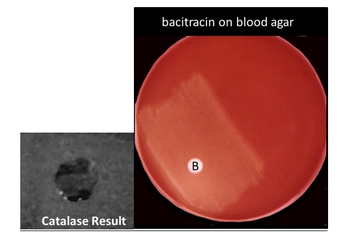
Human Anatomy & Physiology (11th Edition)
11th Edition
ISBN: 9780134580999
Author: Elaine N. Marieb, Katja N. Hoehn
Publisher: PEARSON
expand_more
expand_more
format_list_bulleted
Question
thumb_up100%
What are the results from these two tests? (catalase and bacitracin)

Transcribed Image Text:### Image Transcription for Educational Website
The image displays two tests used for bacterial identification and antimicrobial susceptibility:
1. **Catalase Test Result:**
- This section shows the result of a catalase test. A positive catalase result is indicated by the presence of bubbles, which signifies the release of oxygen gas. This test is used to identify organisms that produce the enzyme catalase, commonly used to differentiate between bacterial species, particularly Gram-positive cocci.
2. **Bacitracin Test on Blood Agar:**
- The second section shows a petri dish containing blood agar with a clear area labeled "B." This demonstrates a bacitracin susceptibility test. A zone of inhibition around the "B" indicates that the organism is susceptible to bacitracin. Blood agar is used as a nutrient-rich medium to grow a variety of bacteria and observe hemolytic activity. The presence of an inhibition zone is critical for identifying specific bacterial isolates, such as differentiating between Beta-hemolytic Streptococci.
The tests depicted are fundamental in microbiology for differentiating and identifying bacteria based on their biochemical and susceptibility characteristics.
Expert Solution
This question has been solved!
Explore an expertly crafted, step-by-step solution for a thorough understanding of key concepts.
Step by stepSolved in 2 steps

Knowledge Booster
Similar questions
- So we did an experiment and I am curious on the following because the prof did not elaborate too much. She just gave the postive result and reagent. 1. What type of reaction occurred when the samples (enumerated) reacted with the Bial’s reagent? Give the chemical equation for each.a. Glucoseb. Sucrosec. Fructosed. Lactosee. Galactosef. Ribose 2. Explain the mechanism behind the test in simple terms. 3. What are the important products of the reaction of each sample?arrow_forwardWhat are the biochemical test used to assay fatty acids and cholesterol?arrow_forwardUrine samples for each patient were tested for ketone bodies, and a Benedict's reagent and glucose oxidase reaction was also completed. The results are given in the table below, with - indicating a negative result and +, ++ and +++ indicating a positive result of different intensity. Patient A Patient B Patient C Patient D Patient E Ketone Bodies +++ Benedict's Reagent +++ - +++ - +++ Glucose Oxidase +++ +++ + 4. For each individual patient A-E, using the WHO guidelines for the diagnosis of diabetes, write a short paragraph to explain: (a) what you can deduce from the fasting blood glucose and the 2 hour sample of that patientarrow_forward
- question 1 : draw an α,α(2, 2) linkage between the two monosaccharides(two fructose ). label the glycosidic linkage. Must be Haworth question 2 : Draw glycosidic linkage between D-glucose linked to D-altrose with a β(1, 3) glycosidic linkage. label clearly the glycosidic linkage. must be Haworth.arrow_forwardPlease help me to find positive or negative results for the Oxidase lab test for microbiology, recognize the species and explain the reason behind the result.arrow_forwardi would like to ask the following questions since it was not elaborated during discussion. In Molisch Test: 1. Why are the results appearing faster in monosaccharides than disaccharides and polysaccharides?2. Why is it negative for tetrose and triose even if they are carbohydrates? In Bial’s Test3. Why does pentose result to blue while hexose result in other color?arrow_forward
arrow_back_ios
arrow_forward_ios
Recommended textbooks for you
 Human Anatomy & Physiology (11th Edition)BiologyISBN:9780134580999Author:Elaine N. Marieb, Katja N. HoehnPublisher:PEARSON
Human Anatomy & Physiology (11th Edition)BiologyISBN:9780134580999Author:Elaine N. Marieb, Katja N. HoehnPublisher:PEARSON Biology 2eBiologyISBN:9781947172517Author:Matthew Douglas, Jung Choi, Mary Ann ClarkPublisher:OpenStax
Biology 2eBiologyISBN:9781947172517Author:Matthew Douglas, Jung Choi, Mary Ann ClarkPublisher:OpenStax Anatomy & PhysiologyBiologyISBN:9781259398629Author:McKinley, Michael P., O'loughlin, Valerie Dean, Bidle, Theresa StouterPublisher:Mcgraw Hill Education,
Anatomy & PhysiologyBiologyISBN:9781259398629Author:McKinley, Michael P., O'loughlin, Valerie Dean, Bidle, Theresa StouterPublisher:Mcgraw Hill Education, Molecular Biology of the Cell (Sixth Edition)BiologyISBN:9780815344322Author:Bruce Alberts, Alexander D. Johnson, Julian Lewis, David Morgan, Martin Raff, Keith Roberts, Peter WalterPublisher:W. W. Norton & Company
Molecular Biology of the Cell (Sixth Edition)BiologyISBN:9780815344322Author:Bruce Alberts, Alexander D. Johnson, Julian Lewis, David Morgan, Martin Raff, Keith Roberts, Peter WalterPublisher:W. W. Norton & Company Laboratory Manual For Human Anatomy & PhysiologyBiologyISBN:9781260159363Author:Martin, Terry R., Prentice-craver, CynthiaPublisher:McGraw-Hill Publishing Co.
Laboratory Manual For Human Anatomy & PhysiologyBiologyISBN:9781260159363Author:Martin, Terry R., Prentice-craver, CynthiaPublisher:McGraw-Hill Publishing Co. Inquiry Into Life (16th Edition)BiologyISBN:9781260231700Author:Sylvia S. Mader, Michael WindelspechtPublisher:McGraw Hill Education
Inquiry Into Life (16th Edition)BiologyISBN:9781260231700Author:Sylvia S. Mader, Michael WindelspechtPublisher:McGraw Hill Education

Human Anatomy & Physiology (11th Edition)
Biology
ISBN:9780134580999
Author:Elaine N. Marieb, Katja N. Hoehn
Publisher:PEARSON

Biology 2e
Biology
ISBN:9781947172517
Author:Matthew Douglas, Jung Choi, Mary Ann Clark
Publisher:OpenStax

Anatomy & Physiology
Biology
ISBN:9781259398629
Author:McKinley, Michael P., O'loughlin, Valerie Dean, Bidle, Theresa Stouter
Publisher:Mcgraw Hill Education,

Molecular Biology of the Cell (Sixth Edition)
Biology
ISBN:9780815344322
Author:Bruce Alberts, Alexander D. Johnson, Julian Lewis, David Morgan, Martin Raff, Keith Roberts, Peter Walter
Publisher:W. W. Norton & Company

Laboratory Manual For Human Anatomy & Physiology
Biology
ISBN:9781260159363
Author:Martin, Terry R., Prentice-craver, Cynthia
Publisher:McGraw-Hill Publishing Co.

Inquiry Into Life (16th Edition)
Biology
ISBN:9781260231700
Author:Sylvia S. Mader, Michael Windelspecht
Publisher:McGraw Hill Education